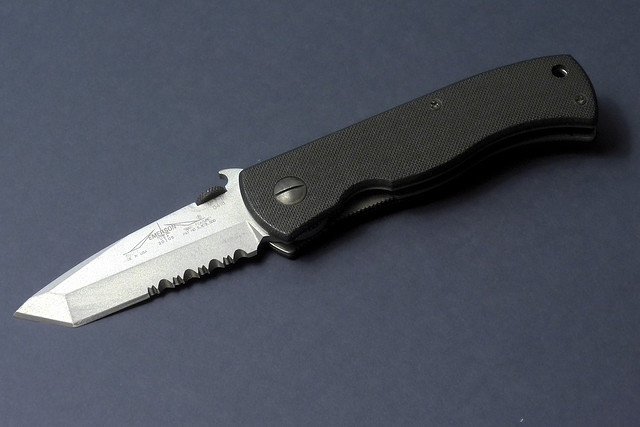Last Updated: October 3, 2016
Tactical knives are trendy, and it’s easy to get swept up in the latest trends. While I have seen a lot of great new knives come out recently, I’m still drawn to the classics… and you can’t talk about classic folding tactical knives without mentioning Emerson Knives.
[easyazon_cta add_to_cart=”default” align=”center” asin=”B00W536APE” cloaking=”default” height=”42″ key=”tall-orange” localization=”default” locale=”US” nofollow=”default” new_window=”default” tag=”brdfkdfk-20″ width=”120″]
In fact, many credit Ernest Emerson with the original folding tactical knife and his decades of work as a custom knifemaker has brought numerous innovations to the industry. Thankfully, Emerson produces a line of production knives that puts his rugged designs within the grasp of the common man (his custom pieces are crazy expensive – if you can even find one for sale). One knife that showcases a lot of what Emerson Knives is all about is the Emerson CQC7. The CQC-7 is also the subject of today’s review.
“CQC” stands for “close quarter combat” and “7” identifies the model in this distinctive series of knives. The CQC-7 was actually based off of Emerson’s CQC-6 design (which is only available as a custom piece) and was licensed out to Benchmade in 1994. After that license expired, Emerson began producing the knife in his own factory. My point here is, this knife has been around the block. It’s a simple and brutally effective tool.
Over the years Emerson has produced a variety of sizes and styles of the CQC-7. I’ll be examining the standard CQC-7 with a 154CM combo edge, G10 scales, Emerson wave (more on that later) and a titanium liner lock.
Intended Use
The CQC-7 is fully intended to be a combat knife. The name alone should be enough to tell you that this knife is designed for up close, last resort, hand-to-hand combat, but I’ll be going into what specifically makes this a weapon. That said, you could also EDC this knife. Aside from its size, it has some interesting nuances that might dissuade you from wanting to carry this knife every day, but I know a lot of people who love the CQC-7 and use it for every day tasks.
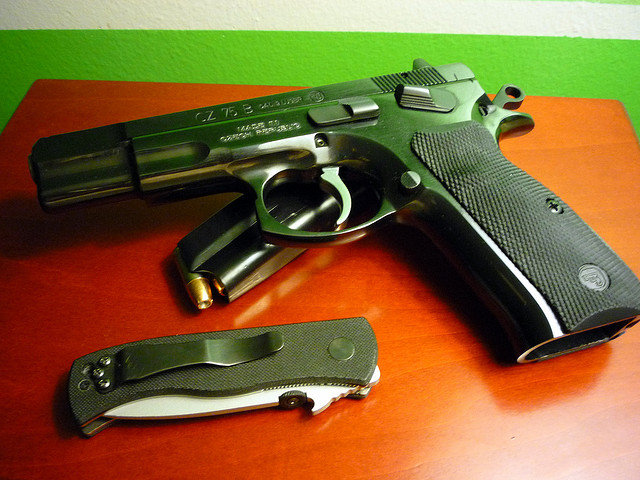
General Dimensions and Blade Details
The CQC-7 has an overall length of 8.0″, a blade length of 3.3″, a weight of 4.0 ounces and is made in the USA. The CQC-7 comes in a couple blade shapes. I’m reviewing the version with the tanto blade shape (CQC-7B) although you can also opt for a drop point version (the CQC-7A) in various finishes. The tanto shape has an inherently strong tip which makes the knife ideal for stabbing and thrust cuts – the kinds of cuts you would be performing in a defensive situation. A downside to the tanto is that I find it harder to sharpen.
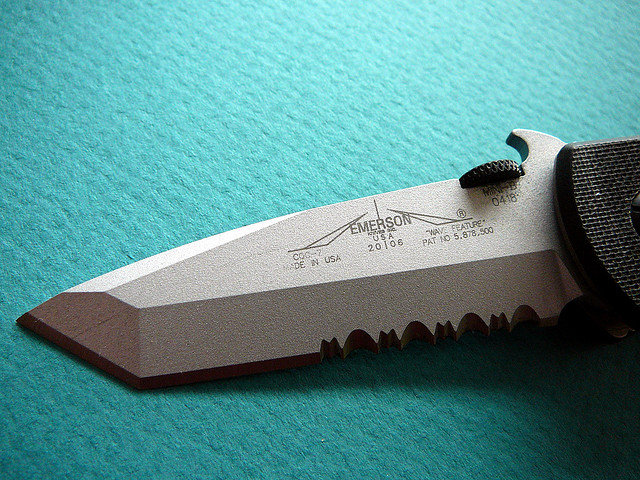
There are 2 very interesting features about the CQC-7 blade that I need to talk about; the wave and the chisel grind.
The Emerson Wave Feature
The Emerson wave is a small protruding piece of metal on the top of the blade (back by the thumb disk) designed for rapid one hand deployment of the knife. It works by catching the wave on the edge of your pocket and forcing the knife open. Operated correctly wave deployment is the fastest way to open up a folding knife. If I did a poor job explaining the wave feature here is a video. (I didn’t film this so don’t blame me if the music isn’t exactly your thing.)
The wave is a great feature if fast deployment is your thing. Other knife manufacturers employ a wave feature but Emerson is the original. One thing to keep in mind is that you have to be careful deploying a knife like this in public because it snaps open so quickly – the average person probably hasn’t seen anything like it.
Chisel Grind
The other major feature with the blade is that it is chisel ground. For those unfamiliar with a chisel grind, it’s exactly what it sounds like – the knife is sharpened on one side only like a chisel, and the “back” of the blade is completely flat. Emerson apparently has their reasons for doing this including that it is easier to sharpen, holds an edge longer, and it has become something of a trademark for them. If you hunt around they do make knives in the more common “V” grind, but the CQC-7 I am reviewing does not have this kind of grind. One issue with the chisel grind is that it is hard to get a straight cut, the blade tends to drift towards the chisel side of the knife. If you are going to use this knife for long and precise cuts you may want to consider a version with the “V” grind.
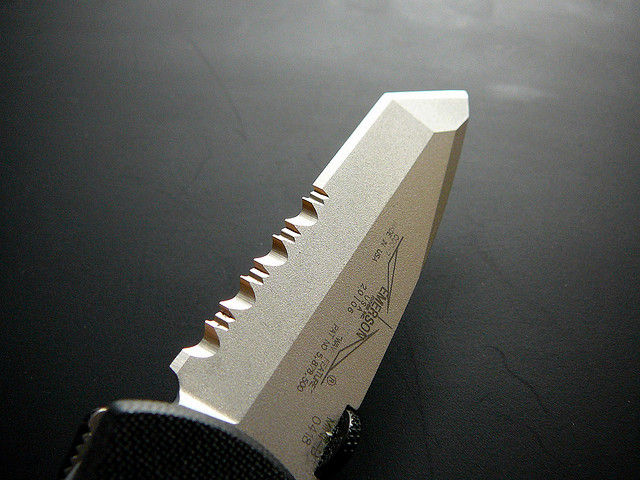
Blade Steel
Emerson went with CPM-154CM steel for the blade. Benchmade uses a lot of 154CM and it is an all around excellent steel. That said, when you consider the price of this knife new (in the $120 range) a lot of people like to see more exotic steels. Honestly, this is another point that I will leave for you to consider. Of course I would like to see a more exotic steel but I think 154CM is very good. I certainly wouldn’t make it into a deal-breaker.
Handle, Ergonomic,s and Pocket Clip
The handle of the CQC-7 is made of G-10 scales over titanium liners. The handle has a glass laminate backspacer and is held together with phillips screws. I always prefer the pillar, or flow-through, construction knives but I know that this knife was meant to be tough so a partial backspacer makes sense as it probably affords more rigidity. I also think that titanium was an excellent choice for the liners. It is both strong and light and is a big part of what keeps this full size folder nice and light. The phillips screws are an interesting touch. Emerson reportedly uses phillips screws for easy take-down in the field – it’s a little different and I like it.
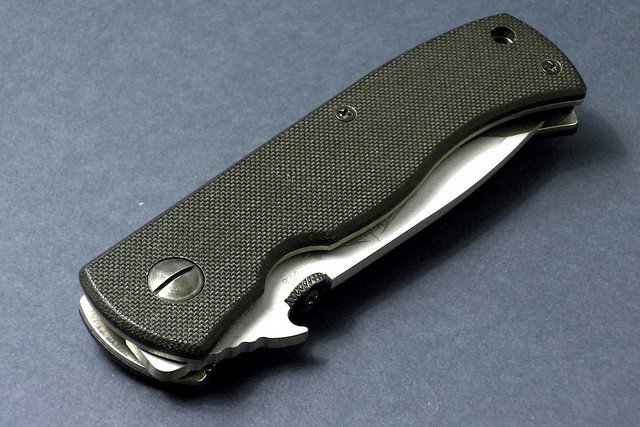
The ergonomics on the CQC-7 is where this knife really shines. The handle is spacious and the edges are perfectly contoured to meet the hand. The G10 is nicely textured to provide good grip. There is some jimping on the large thumb ramp as well as the choil although the thumb ramp jimping is still pretty smooth. This knife feels great in both forward and reverse grips and is built like a tank. These are major concerns for a fighting knife so it’s no surprise that “the original tactical knife” has great ergonomics and solid construction.
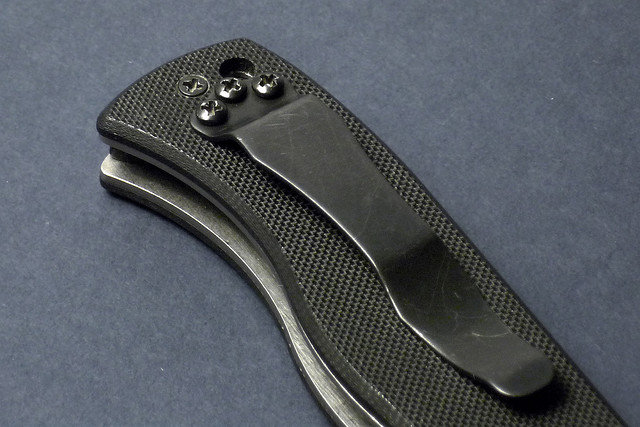
The pocket clip is superb if you are right handed. It is blackened, and has great retention. Unfortunately, the clip is not ambidextrous. In my opinion this is a major misstep. Also, the clip isn’t reversible from top to bottom so you are left with tip up carry only. If you are right handed and want to use the wave feature this should be fine, but for everyone else the non-positional clip leaves something to be desired.
Deployment and Lock
The CQC-7 has two main deployment options, the wave and the thumb disk. I’ve already spoke at length about the wave method of deployment and there isn’t a whole lot to say about the thumb disk. It is a disk that sits on top of the blade and functions like a thumb stud. It is big and the edges are ridged and provides a lot of room for you to easily deploy the knife with your thumb. I like the thumb disk, and with a little practice it becomes very natural to open the CQC-7.
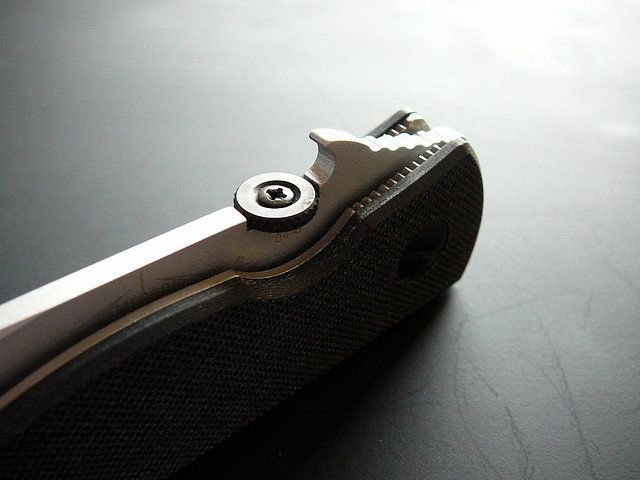
The pivot screw of the CQC-7 is actually a flat head screw. This is another departure from most “normal” folding knives where you will find a torx or allen head pivot screw. Again, Emerson selected this for ease of take down in the field. I find the slot of the screw to be a little thin and impractical, but if you had to take this knife apart in the field it could be done.
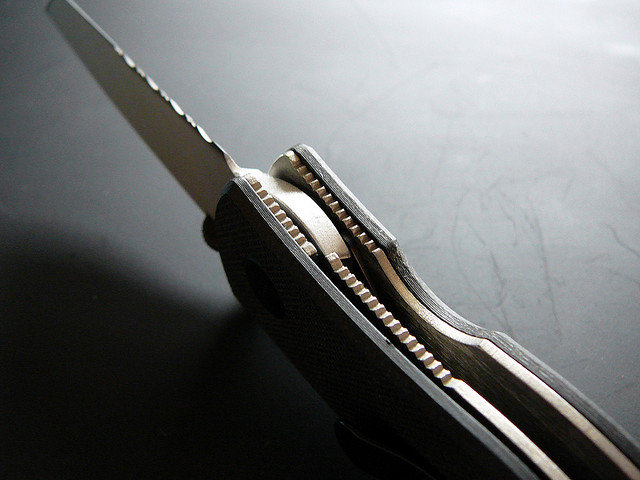
Emerson selected a titanium liner lock for the CQC-7. The lock is adequately thick and does a good job holding the blade in place with zero play in any direction. That said, for a combat knife you might want something more substantial like a frame lock, axis lock or even a lock back. Knifemakers are raising the bar and I have reviewed a number of knives with solid titanium frame locks. The CQC-7 might be a little behind the times here although I think if Emerson added a frame lock it would probably push the price right up to the $200 mark.
Emerson CQC-7 Review – Final Thoughts
After handling a number of production blades, I can safely say that the CQC-7 is a really unique folding knife. The wave feature, chisel grind, and nuances in design and construction make this a “love it or leave it” type of blade. Some guys only carry Emerson knives while others have had a few and decided to trade or sell them off.
Personally, the quality and history behind the knives intrigues me but I am somewhat turned off by the chisel grind, relatively high price tag, and especially the non-ambidextrous pocket clip. That said, Emerson does make dedicated lefty models and there is plenty left to appreciate about this knife. The rugged design, solid build quality, and details that make an Emerson, well, an Emerson continue to please a large number of tactical knife enthusiasts.
[easyazon_block add_to_cart=”default” align=”center” asin=”B00W536APE” cloaking=”default” layout=”top” localization=”default” locale=”US” nofollow=”default” new_window=”default” tag=”brdfkdfk-20″]
I recommend purchasing the CQC-7 at Amazon or BladeHQ. BladeHQ has a great selection of CQC-7s and their prices are very competitive. Purchasing anything through any of the links on this site helps support BladeReviews at no additional charge to you. Any and all support is greatly appreciated – thank you very much.
Photo Credits: Many thanks to Mr. Smashy for the great pictures of the CQC-7. Thanks again Smashy!
Please note that these pictures are actually of the Mini CQC-7 but the knives look very similar (with the only difference being the overall size of the knives).
